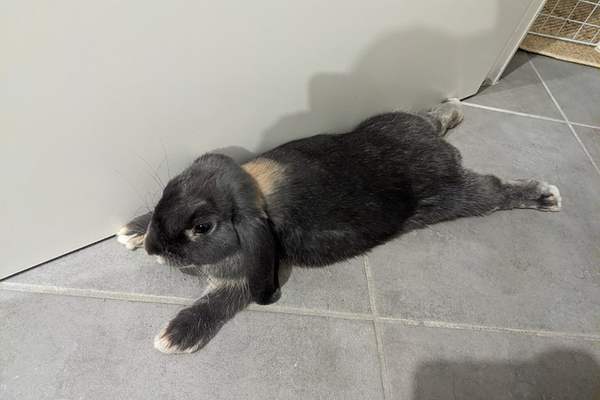A rabbit’s foot is thought to be a lucky charm, and you’ve probably heard of someone who keeps one on their keychain. But what exactly do we know about rabbit feet? Do rabbits have long feet?
These incredible creatures are extremely fast animals that can move in all directions. Their long legs also assist them in jumping to move to different locations or escape predators. In this article, we’ll look at how rabbits use their feet to help them survive in the wild.
Key Takeaways:
- Rabbits have long legs and large feet that help them jump.
- These species hop with their toes rather than their feet flat on the ground, which is known as digitigrade locomotion.
- Despite having very similar appearances, rabbits and hares differ greatly from one another.
Do rabbits have long feet?
Rabbits are known for have powerful hind legs, and fairly long rear feet. Now long is relative so it depends on what you’re comparing their feet to. If you look at the below diagram you can see that a rabbits foot consists of three main parts; the foot phalanges, the metatarsus, and the tarsus.

A rabbit sits on its entire foot when it’s in sitting position, unlike humans that sit on their behinds only. These adorable creatures also have long legs in general that work in tandem with their long feet for jumping, hopping and digging.
What are rabbits’ feet called?

Rabbits are small mammals with five toes on their front paws and four toes on their hind feet. These creatures’ front feet are known as forefeet, while their back feet are known as hind feet. Because rabbits’ feet are covered in hair and fur, their toes aren’t as visible as those of other animals.
Rabbits’ large feet
Rabbits have large feet because they’re ground-dwelling animals. Their feet assist them in digging burrows, hopping, and jumping. They also require large feet for support when these animals are standing on their hind legs or sitting down to rest.
Since they can’t run, their feet work together to allow them to hop very quickly and escape predators when necessary. They accomplish this by pushing their weight from their hind feet, causing them to leap forward while their forefeet prepare for the impact, and then repeating the process.
Why do rabbits have long back legs?

Rabbits have long back legs and short front legs because they’re members of the Lagomorph family, which uses these features to move forward by jumping, just like hares.
Because of the way their skeletal structure is built, their way of life has also been modified to fit this. They also use their legs and feet to dig holes and build burrows where they can sleep, nest, and hide from predators.
Advantages of rabbit’s large feet
Rabbits have large feet and long claws that help them dig

Rabbits also have long claws on their feet, which allow them to dig more effectively when looking for food or nesting sites. They dig up root vegetables from the ground with their front feet as shovels. This is crucial for these species because they also dig their own resting burrows and warrens.
Big feet support them to jump faster
When a rabbit hops, their large feet provide them with more surface area. This enables them to change direction quickly when they jump, which is an important advantage in their natural habitat, particularly when attempting to escape predators.
For self-defense
The rabbit’s large feet with sharp claws can help them fight off predators to survive. Due to their lack of defense, these cuddly animals are creatures that’ll simply run and hide from danger. When they’re cornered by predators and have no other option, their large feet with sharp claws can help them fight off and gives them a chance to survive.
Speed of rabbits

Rabbits are prey animals, but you might be surprised at how fast they’re if you try to catch them in the wild. These adorable creatures are extremely fast, reaching speeds between 25 and 45 miles per hour. They have strong hind legs that provide extra propulsion when fleeing danger, which is when they need it the most.
Do rabbits use plantigrade or digitigrade during locomotion?
Plantigrade animals walk with all four feet in contact with the ground, as humans do. These animals have short limbs and are generally slow, but they can move quickly when needed.
Digitigrade animals, such as dogs and cats, are built to be able to walk on their toes. This allows them to move faster than plantigrade animals while maintaining their balance and moving quickly without falling over.
For hopping, rabbits use digitigrade locomotion. The rabbit’s feet is relatively slightly off the ground when it hops using digitigrade locomotion, which helps it escape predators by being able to hop faster than some animals.
Difference between rabbits and hares
Rabbits and hares have nearly identical appearances and are members of the same Leporidae family. Many people are perplexed by these two since they both hop around, but despite their similar appearances and movements, rabbits and hares are two distinct species.
- Rabbits and hares are both furry animals with long ears and hind legs, but hares are much larger and have longer legs and ears than rabbits.
- Rabbits prefer soft plant materials and vegetables like grasses, leaves, and carrots, whereas hares prefer tougher plant materials like twigs, roots, and barks.
- Unlike rabbits, which dig their own holes and turn them into burrows with many tunnels for sleeping, nesting, and avoiding danger, hares live above ground in empty logs and nest in a shallow depression in the ground known as a form.
Final Thoughts
So, do rabbits have long feet? It depends on how you look at it, but when you look at a rabbit in sitting position they do appear to be long in comparison to the rabbit’s size.
A rabbit’s rear feet are large and work in tandem with their strong legs to give this animal an advantage in the wild, such as digging, moving quickly to avoid predators, and defending themselves. Their front feet are rather small and not what most would consider to be long feet.

